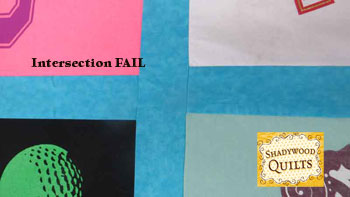Shadywood Quilts
Professional Machine Quilting
How to Make Quilt Sashing With Cornerstones
Types of Quilt Sashing
First of all there are several types of quilt sashings. The basics for creating the sashing is the same for each style, the difference is how many sashings, how complex the piecing is, and how many sashing units and cornerstones?
Sashing: The fabric that separates blocks in a setting, framing them and making the quilt larger. There are two basic kinds of sashing -- continuous and sashing with sashing posts (cornerstones)
Cornerstones: Generally a small square piece of fabric used at the intersection of blocks or sashing sections of a quilt top .
More Quilting Terms and Definitions.
Cornerstones Do Not Need To Be Plain Squares
 Quilt sashing can be continuous, no cornerstones, with no cornerstones, or just a LOOOONNNNG strip of fabric sewn as a row between the quilt blocks. The image to the right shows the problem most quilters have with just using a long strip of fabric. There are several problems with this. Like lining up those pesky blocks.
Quilt sashing can be continuous, no cornerstones, with no cornerstones, or just a LOOOONNNNG strip of fabric sewn as a row between the quilt blocks. The image to the right shows the problem most quilters have with just using a long strip of fabric. There are several problems with this. Like lining up those pesky blocks.
Cornerstones serve several purposes:
- Help you line up your quilting**
- One more way to add color and visual interest to a quilt.
- Try small four-patch cornerstone units?use their dark (or light) squares to create a continuous diagonal flow across the quilt.
- Any square patchwork unit that works with the width of your sashing can be used to make traditional cornerstones.
Materials Needed
To make sashing and cornerstones you will need fabric, thread, measuring tools, cutting tools, sewing machine, and iron.
All the usual sewing/quilting tools.
What size are the quilt blocks? If the unfinished size of the block is 12.5" (unfinished), then you just need the sashings to be 12.5"
Easy! The WIDTH of the sashing can vary. A very popular size for 12" (finished) blocks is a 2 inch (finished) sashing.
Good to Note: If the sashings are 2.5" (unfinished), then the cornerstones would be 2.5 squares (unfinished).
Tools:
- June Tailor 20-Inch-by-23-Inch Shape Cut Pro Ruler This is my MOST FAVORITE tool for cutting 2.5" strips. It allows you to cut 2.5" strips from 40 - 45" fabric, about eight at a time. We used this in our T-shirt quilt business.
Straight Set Quilt
Sewing sashing between your quilt blocks is one way to add another design element to the quilt's layout. It has these uses:
- Sashing frames the quilt blocks.
- Sashing is often the perfect choice for a sampler or 'busy' quilt blocks. Sashing offers a bit of separation for patchwork blocks that might not look as attractive when they are sewn side-by-side. Gives the eye a place to rest.
- Sashing increases the quilt's final dimensions.
- Sashing can help you square up blocks that are slightly different sizes, using the same technique used to sew borders to a quilt. Say you inherit some blocks that vary in size. By adding sashing, then sizing the blocks to a consistant size. You end up with a successful quilt.
It's easy to sew sashing to a quilt, especially straight-set layouts. Since they don't require triangles or strips with angled edges as on-point settings do.
Diagonal Set Quilts
Sashings work the same whether you are making a straight set quilt or a diagonal set quilt. The size of one edge of the block.
How to Add a Simple Sashing to Your Quilt
- Cut the Sashes.
- Measure the height of your quilt blocks, then cut out the sashing strips to fit. (i.e. if blocks are 12.5 inches, the sashings would be cut 12.5 inches in length.
- Sew and Press. Sew the quilt blocks to the sashing strips, then press the seams toward the sashing.
- Measure the Row. ...